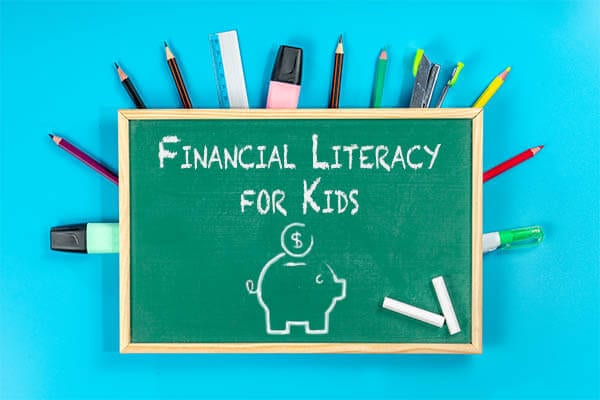Financial Literacy for Kids
Financial Literacy for Pre-school, Pre-K, Kindergarten, First and Second Grade
The following lessons provide guidance, lesson plans and activities for teachers interested in introducing four to seven year old children (pre-school, pre-k, first and second grade) to early financial literacy concepts.
Lesson One: Making Spending Decisions
From birth, a child has choices. At first parents make the decisions, but before the end of the first year, children are capable of making some simple selections. If children are allowed to make easy choices as toddlers, then making decisions for themselves as they grow becomes less difficult. This lesson introduces guided, money-related, decision-making activities for children in preschool and kindergarten.
Teacher’s Guide – Lesson One: Making Spending Decisions
Student Guide – Lesson One: Making Spending Decisions
Lesson Two: Spending Plans
Preschool-aged children are capable of learning simple spending plans. Early training in categorizing money establishes patterns for future money-management behavior. This lesson introduces children to the concept of dividing their money into categories, namely “save,” “spend,” and “share.” We present activities that will help children understand that money is limited in quantity and must be divided for different purposes.
Teacher’s Guide – Lesson Two: Spending Plans
Student Guide – Lesson Two: Spending Plans
Lesson Three: Earning Money
Adults must earn money to provide for their needs and wants. In this lesson children learn that money is earned and does not come free. Children also learn that money is limited in quantity. Early training in earning small amounts of money provides a foundation and understanding that work and money are connected.
Young children perform certain tasks at home just because they are part of the family or household. Children can do additional tasks to earn money for their spending plans. Children need to distinguish between shared responsibilities as members of a family and responsibilities that earn them money. This lesson introduces young children to activities and ideas for earning money. The money earned helps children meet their financial goals. Remember that the financial goals for a preschool-aged child may seem simple to an adult, but they are not simple to the child. Children learn the concept that money is a reward for working.
Teacher’s Guide – Lesson Three: Earning Money
Student Guide: Lesson Three: Earning Money
Lesson Four: What is Money?
Money is the medium of exchange for most goods and services. Different coins and paper money have different values. Children need the ability to recognize the names and values of different coins and bills used in exchange for goods and services. This lesson helps children identify the names of coins and grasp their relative values in terms of purchasing power. We present games and activities that will help children acquire this knowledge.
Teacher’s Guide – Lesson Four: What Is Money?
Student Guide – Lesson Four: What Is Money?
Financial Literacy for Grades 3-6
The following lesson plans are designed for elementary school children in the following grades: third grade, fourth grade, fifth grade and sixth grade.
Lesson One: Allowances and Spending Plans
Children in grades three through six are capable of managing small amounts of money. They can divide their money into several categories, including “spend,” “save,” and “give.” At the same time, they can spend their money and keep a record of what was spent. This lesson provides an introduction to allowances for third through sixth graders. Allowances are the first step to understanding written spending plans or budgets. With guidance managing allowances in childhood, children can become financially responsible adults. Adults with effective budget skills create healthier family relationships and contribute to building a stronger economy.
Teacher’s Guide – Lesson One: Allowances and Spending Plans
Student Guide – Lesson One: Allowances and Spending Plans
Lesson Two: Money Responsibility
Successful money management includes keeping records of money spent. This includes having the skills to know how much money is available, how much money has been spent, and how much money must be saved for future needs. This lesson introduces elementary-aged children to the concept of being responsible for managing money through accurate record-keeping. It provides them with activities and worksheets that demonstrate the need to be accountable for how they spend and save money.
Teachers Guide Lesson 2 Part 2: Money Responsibility
Student Guide Lesson 2 Part 2: Money Responsibility
Lesson Three: Saving and Investing
Part of learning about money management includes knowing where to put savings. The value of savings increases differently depending on how the money is managed. Placing savings in something beyond a savings account introduces students to the world of investments. When they become adults, these students will have control over where they invest their money for retirement. It is important that they understand how to get the best growth for their money. At the same time, they need to understand the chances of losing that money in investments. This lesson introduces students to the basics of how money grows through saving and investing. It introduces the concepts of financial risk and rates of return.
Teacher’s Guide – Lesson Three: Saving and Investing
Student Guide – Lesson Three: Saving and Investing
Lesson Four: Comparison Shopping
This lesson introduces students to the concepts associated with comparison shopping and choosing the best option. The activities in this lesson will introduce students to the difference between needs versus wants. Students will also learn to scrutinize advertising to discover messages that may affect their decisions.
Teacher’s Guide – Lesson Four: Comparison Shopping
Student Guide – Lesson Four: Comparison Shopping
You will need Adobe Reader to view the Workbook and Worksheets PDFs on this Page: Download Adobe Reader

